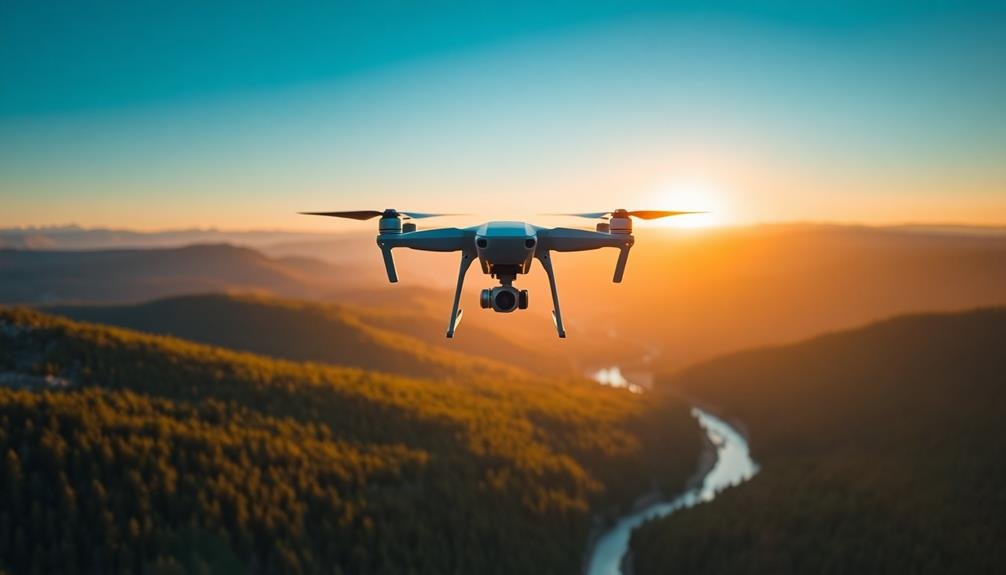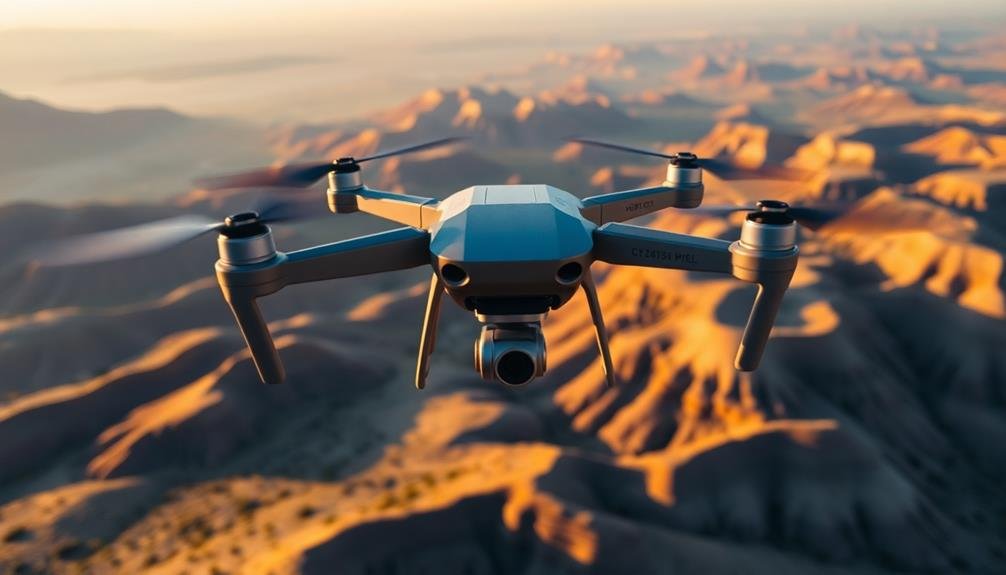To capture stunning aerial drone slider shots, focus on mastering smooth altitude changes by using slow ascent/descent rates and altitude hold modes. Perfect your linear motion with intelligent flight modes and slow, steady speeds. Utilize automated features like Cable Cam or Waypoint modes for consistent, pre-programmed paths. Incorporate interesting foreground elements to add depth and framing to your compositions. Experiment with speed variations to create dynamic shots, from serene landscapes to high-energy sequences. By combining these techniques, you'll elevate your drone videography to new heights. Discover how these pro tips can transform your aerial footage into cinematic masterpieces.
Key Takeaways
- Master smooth altitude changes with precise throttle control and slow ascent/descent rates for cinematic movements.
- Perfect linear motion using intelligent flight modes and maintain slow, steady speeds for smoother footage.
- Utilize automated flight modes like Cable Cam or Waypoints to focus on composition and camera control.
- Incorporate interesting foreground elements to enhance visual appeal and frame subjects effectively.
- Experiment with speed variations to add depth, drama, and visual interest to your aerial slider shots.
Master Smooth Altitude Changes

Altitude control is key to capturing stunning aerial slider shots. To master smooth altitude changes, you'll need to practice precise throttle control. Start by setting your drone to a slow ascent or descent rate, typically around 1-2 meters per second. This allows for gradual, cinematic movements that won't jar your viewers.
As you fly, focus on maintaining a consistent speed throughout the shot. Use visual references in your frame to gauge your ascent or descent rate. Try to keep a steady hand on the controls, avoiding sudden jerks or adjustments. If your drone has altitude hold or tripod mode, utilize these features to stabilize your vertical movements.
Experiment with different altitudes to add depth and perspective to your shots. Low-altitude slides can create a sense of intimacy, while higher altitudes offer sweeping vistas. Combine altitude changes with lateral movements for dynamic compositions.
Practice shifting between altitudes smoothly, perhaps starting low and gradually rising to reveal a landscape. Remember to adjust your camera angle as you change altitude to maintain proper framing.
Perfect Your Linear Motion

In addition to altitude control, mastering linear motion is essential for creating enchanting aerial slider shots. To perfect your linear movements, start by practicing with simple, straight-line flights. Use your drone's intelligent flight modes, such as "Point of Interest" or "Waypoints," to maintain a consistent path and speed.
When executing linear motions, keep your drone's speed slow and steady. This allows for smoother footage and gives viewers time to absorb the scene. Aim for a speed of 1-3 mph for most shots, adjusting as needed based on your subject and desired effect.
Pay attention to your start and end points. Begin your movement before you intend to use the footage, and continue past your planned end point. This gives you more flexibility in post-production editing.
To add depth to your linear shots, incorporate foreground elements. Fly past trees, buildings, or other objects to create a sense of movement and scale. Remember to maintain a safe distance from obstacles.
Experiment with different angles during your linear flights. Try side-to-side movements, push-in shots, and pull-out shots to add variety to your footage. Always prioritize safety and follow local drone regulations while perfecting your linear motion techniques.
Utilize Automated Flight Modes

Many modern drones come equipped with automated flight modes that can greatly enhance your aerial slider shots. These pre-programmed flight patterns allow you to focus on composition and camera control while the drone handles the movement.
Take advantage of modes like "Cable Cam" or "Waypoint," which let you set start and end points for smooth, linear flights. When using these modes, you'll need to scout your location and plan your shots carefully. Set your waypoints or cable cam endpoints with precision, ensuring there are no obstacles in the drone's path.
Don't forget to take into account lighting conditions and background elements when choosing your flight path. Experiment with different speeds and altitudes to create varied effects. Slower movements often result in more cinematic footage, while faster speeds can add energy to your shots.
Combine automated modes with manual camera control for even more creative possibilities. You can adjust gimbal angles or zoom during the flight to add dynamic elements to your slider shots.
Remember to practice these modes in a safe, open area before attempting complex shots. With time and experience, you'll master these automated flight modes and elevate your aerial slider shots to new heights.
Incorporate Interesting Foreground Elements

While automated flight modes can create smooth movements, adding interesting foreground elements to your aerial slider shots will greatly enhance their visual appeal. Look for objects that can frame your subject or add depth to your composition. Trees, buildings, or natural formations can serve as excellent foreground elements.
When incorporating foreground elements, consider their placement within the frame. Position them off-center to create a more dynamic composition. Experiment with different angles and heights to find the most visually appealing arrangement.
Here's a table of foreground element ideas for various environments:
| Urban | Natural | Industrial |
|---|---|---|
| Skyscrapers | Trees | Smokestacks |
| Bridges | Mountains | Cranes |
| Statues | Rocks | Silos |
| Billboards | Waterfalls | Towers |
| Street lamps | Cliffs | Warehouses |
Remember to maintain a safe distance from these elements while flying your drone. As you move through your slider shot, pay attention to how the foreground elements interact with your main subject. This interplay can create a sense of depth and movement, making your aerial footage more engaging and visually striking.
Experiment With Speed Variations

Speed is a powerful tool in your aerial cinematography arsenal. By experimenting with speed variations in your drone slider shots, you'll add depth, drama, and visual interest to your footage.
Start by mastering the slow, smooth movement that's become a hallmark of professional drone cinematography. This technique allows viewers to absorb the details of the landscape and creates a sense of serenity.
Next, try ramping up the speed mid-shot. Begin with a slow glide, then gradually increase velocity. This acceleration can build tension or convey a sense of urgency. Conversely, you can start fast and decelerate, which works well when revealing a stunning vista or point of interest.
Don't shy away from extreme speeds. Quick fly-bys can inject energy into your sequence, while ultra-slow movements can create a dreamlike quality. Experiment with varying speeds within a single shot, alternating between fast and slow segments. This technique can guide the viewer's eye and create rhythm in your composition.
Remember to adjust your camera settings accordingly. Faster movements may require a higher shutter speed to maintain sharpness, while slower shots allow for longer exposures and smoother motion blur.
Frequently Asked Questions
What Drone Models Are Best Suited for Aerial Slider Shots?
You'll want drones with smooth flight capabilities and advanced GPS for aerial slider shots. Consider models like DJI Mavic 3, Autel EVO II Pro, or Skydio 2+. They offer stability, precision, and intelligent flight modes for cinematic results.
How Do Weather Conditions Affect Aerial Slider Shot Quality?
You'll find weather greatly impacts your aerial slider shots. Wind can cause shaky footage, while rain or fog obscures visibility. Bright sunlight may create harsh shadows. Aim for calm, overcast days for the best results.
Are There Specific Camera Settings Recommended for Aerial Slider Shots?
For aerial slider shots, you'll want to use manual settings. Set a fast shutter speed to reduce blur, a low ISO for less noise, and a mid-range aperture for depth. Don't forget to adjust white balance for the lighting conditions.
What Legal Considerations Should I Be Aware of When Filming Aerial Sliders?
You'll need to follow local drone laws, obtain necessary permits, and respect privacy. Don't fly over restricted areas or crowds. Always maintain visual line of sight and be aware of altitude limits and no-fly zones.
How Can I Maintain Focus on Moving Subjects During Aerial Slider Shots?
You'll want to use your drone's tracking features to lock onto moving subjects. Keep your movements smooth and steady. Practice flying at different speeds and angles to maintain focus while capturing dynamic aerial slider shots.
In Summary
You've now got the tools to elevate your aerial slider shots. Remember, practice makes perfect. Don't be afraid to experiment with different techniques and push your creative boundaries. As you master these pro tips, you'll create more dynamic and visually stunning footage. Keep challenging yourself, and soon you'll be capturing breathtaking aerial slider shots that'll leave your audience in awe. Now go out there and let your creativity soar!

As educators and advocates for responsible drone use, we’re committed to sharing our knowledge and expertise with aspiring aerial photographers.




Leave a Reply